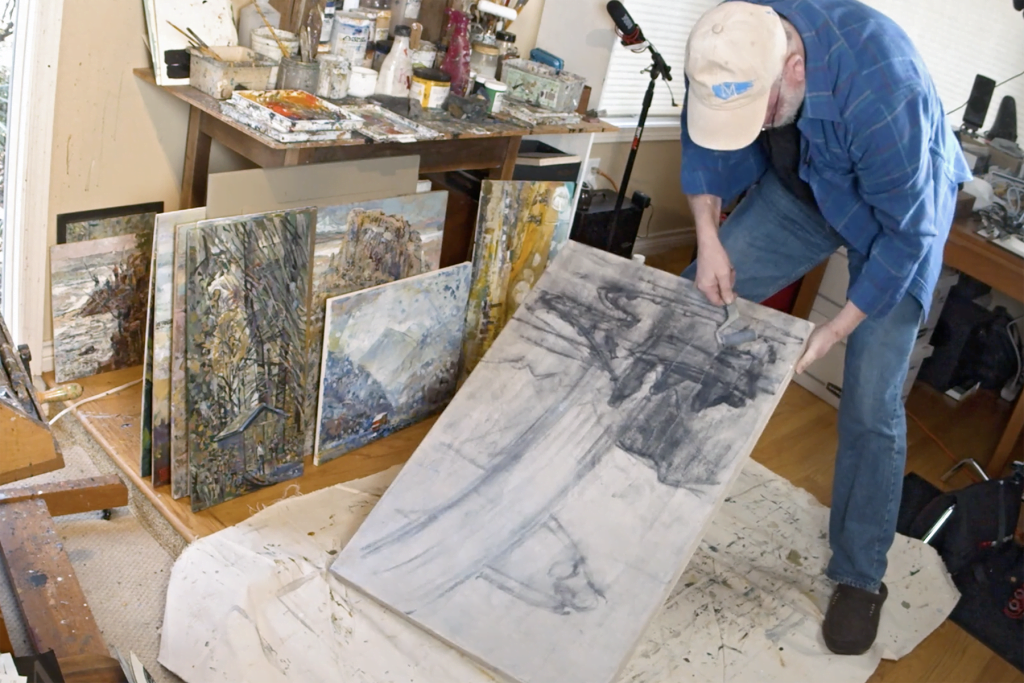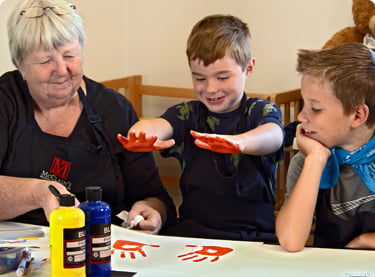Thanks for joining us again for another free art lesson from Golden Road Arts. Last time, Barbara Mason showed the process for making antlers – How to Make Moose Antlers.
In this lesson, Oregon painter and printmaker Erik Sandgren demonstrates the first stages in the process of creating a painting called “Fish Fishermen Rain Rainbow.”
Inspiration and Layout for a Charcoal Painting Video
Find out how Erik Sandgren starts a painting using inspiration from landscapes in Oregon. Use charcoal to develop the layout for your painting.
Materials Required for Charcoal Art
- Charcoal
- Acrylic painting paper
- Charcoal fixative
- Cloth
- Matte medium paint
- Roller
Scroll down to see images from this free art lesson.
Watch the Charcoal Art Come to Life
Follow along with the video transcript and learn how Erik starts a new painting. See how nature can inspire the artistic process in Part 1 of this series.
Well, hello, my name is Eric Sandgren. And I’m a painter/printmaker, living, and working here in just outside of Hillsboro, OR. Monet had the Garden of Giverny that he designed and built for himself, and I have the whole Oregon coast and the Columbia Gorge and Willamette Valley and the Tuality Plains. My wife of 43 years is a painter and I’m a painter. My father was a painter, and so I guess you might say it’s kind of a generational thing and this is what we do. Welcome to my studio.
One thing we talked about – maybe starting a painting anew and is this a good time to do that? Okay. Well, I often paint outside, so I work from plein air and, just as often, I work from sketches. So, this is a sketch from a notebook that I happen to have photographed, and it went to the computer and that’s a printout. But there’s a well-known northwest painter named Carl Hall, who called the artist sketchbook, every sketch in a sketchbook, is money in the bank, he said. And I have found that to be very true. I draw on everything. I have proper sketchbooks and I save little pieces of paper that are remnants of printing processes, and I’ll draw in the car from whatever is out the windshield and little scraps of paper and throw those in a box and look through them. And every once in a while, something appeals to me.
And so, this fits a preoccupation that I’m developing, and I want to do a painting for “Save Our Salmon” and “Artists Against Extinction”, which is a group of artists I’ve been invited to join, including Ray Troll and Alfredo Arreguin. So, I’m really happy to be in good company and others I don’t know yet. But we’re working to depict salmon in a way that will raise people’s awareness of the difficulties its traditional range and environment is having and all that.
And I’m going to begin this painting based on this sketch that is dated 2015 and is all of a sudden relevant to me again. So, there are photographic ways of transferring that drawing, but I believe very much in replicating and redoing and revising because an image picks up depth and information every time you undertake to do it again or do a version of it again. But I love these old artists ways of transferring. So instead of doing it photographically, I’ll do it just, you know, mechanically.
And there’s a rule that artists have been using since the medieval period, you know, about enlarging a rectangle. So I’ve deliberately chosen a canvas so that I can increase the size of that rainbow, but at the same time just for transferring it, I’m going to run that diagonal off the original rectangle which is aligned with the rectangle. And where that diagonal from corner to corner intersects this vertical over here, automatically that gives me the proportion. I’ve transferred the proportion of this to this other, and that will really, I think, kind of help me transfer this thing.
So, the elements that I have to work with here, and I’m not interested in copying this drawing. What I am interested in is this big sort of a dark shape here. A big dark shape comprising boat and fishermen, and these are gillnet fishermen that I drew up on Gray’s Harbor when I lived there on the Chehalis River. And they’ve got a license to fish. And this man here at the front is standing and holding a net and that net comes all the way out here and swirls around this way and this gillnet is kept afloat in the water by a series of these styrofoam, these days, they used to be wooden, floats. And those white floats always struck me as being beautiful the way they lie in the water, like a chain of pearls or like a path of shells. And so, my basic feeling is I want this to be the dark shape which my drawing conveys here. Now I just knock that in there, so I have some sense of it.
And then, silhouetted against this light is a fish and then a little bit of another fish coming out of the water. So, the image is really about man and fish and a big rainbow coming down. So, for me, the exciting thing for me about the image is the continuity. And you asked David about composition and that to me is the composition. It Is the big gesture of a painting like this. And the work comes in a way that’s exciting and in a way that’s intuitive and a joyful and motivating part of the whole process. And then, it’s often a lot of work to try to get these details, if you were, in the specific incidents to corroborate that composition – that initial compositional idea.
So, I have a little bit of a distance back here, and so we put this in the context of, as opposed to being shaped, those big shapes become the mountains surrounding our west coast estuaries. And for me, although the origin of this was decidedly the Chehalis River, I’m going to generalize it, so it talks about the whole Northwest and that’s what I refer to. My big project is to evoke or to document or respond to what I call the “Deep Northwest”, which is this ancient intertwine between human activity and the natural world, which we participate in in different ways here.
So, I’m wondering, now I come to a question. My drawing has this arc and I’m not sure that that’s the arc I want. So, I’m deliberately trying to avoid being too specific and I like this idea up here. There’s a cloud and that’s kind of like, vaguely, fish-like. So, now I want a vaguely salmonoid . Now, this proportion doesn’t help me or anything anymore, but I have this vaguely salmonoid cloud, and I don’t want to get too cute and make it into a fish, but I do want a sense of some kind of presence up there because the cloud and the rainbow are really the connection of the fish or the landscape and the fish to the water cycle and to everything that makes this nature. This natural phenomenon, you know of the salmon, so phenomenal and amazing and moving and you know, maybe I think it’s fair to say spiritual.
So, I’m changing the angle of this boat a little bit so it’s a little more dynamic spatially. My initial conception was to have it, you know, just depict it very straightforward. Maybe it’s the way I saw it on the river, but flat to the perpendicular to your angle of vision or parallel to the picture plane. But in this case, I’m going to develop it as a kind of a three-quarter view. And make sure that I place that engine back there as part of the figure.
I guess that’s the art of it to me is, yeah, we got these engines and, in and of themselves, that’s not something I necessarily want in a painting. But one, it’s the fact, and two, there’s a way to do it where it joins with the figure – it becomes a single shape, a single expressive shape. And so, in the long run, I’m not going to fuss with that too much because this is fugitive charcoal that comes and goes. That’s why we use charcoal, goodness, so that you can revise and I love this arc here of the net. That’s very important and my drawing isn’t helping me much anymore with how I’m going to make it around that corner. And there’s a negative space there. I’m wondering if that should be here. I wonder what would happen if this net came out a little further and those are decisions I can’t make yet, I don’t have enough criteria. What I do want is to keep returning to this idea of the rainbow coming all the way from the top. So that to me is kind of, not to be too corny about it, but I kind of think of it as a gift from heaven.
And I think we’ve got something about the right scale here. This figure is too big. I’m not worried about that kind of thing right now. Sometimes there are three people on a boat. Here’s the box that they put the fish in. I can increase the shape of the gunnels on that boat. So, I’m thinking, you know, curve, curve, curve, curve, you know, and so they’re right-angle alignments. But I’m playing those curves against those right angles. There’s this big thing, this thing is probably interesting, isn’t it? So, if I were to echo that line there, it might happen at these levels. So, I’ve got a lot, there’s a lot to work with here already.
And so now we have this problem. A lot of people are put off by charcoal. I love it because it’s like a Neolithic stone tool. It changes as you use it. So, one minute that’s the edge and already that’s worn down and I have to move that piece to pick up another edge. So charcoal is really extraordinary that way and every piece since it’s wood, it’s organic it’s different, different hardness, different texture. So, it’s a very responsive thing, but some are just worried that now they have all this black dust that’s going to get in their painting. And I’ve always kind of treasured that in a way. I’ve got some elements here that are not going to come clean and there’s so many different ways to work with the acrylic. I’m done with this drawing, by the way. It has served its purpose.
Generally, what I try to do is simply fix this and you can do it with some kind of charcoal fixative material. But in the interest of painting and moving this painting forward, what I generally do is I’m going to put this down here like this, and I’m going to take this and put it right here and then I’m just going to work here for a couple of minutes.
To fix this charcoal and to give me a nice wet bed of paint, I just put matte medium on this. It’s always shocking, and I kind of like violating it that way, but this will dry clear, and this is the medium for acrylic paint and this medium is chemically Rhoplex AC 33 or used to be. And it’s the stuff that binds the pigment to the support in acrylic paint. And so, they’ve been around really, commercially available since the late 50s. And they’ve continued to undergo a lot of evolution for the advantage of artists, and of course they’re used in all kinds of commercial applications too.
But you’ll see that my roller picks up that little bit of the charcoal. I don’t mind that. Every once in a while, I’ll do a drawing that I don’t want to scuff up as much as I’m scuffing this one up, but to me this is a quite acceptable way to go, and it loosens those lines and frees me up to be able to reinvent them as I begin to add color. And so, as you can see, I have a kind of a slightly greyed ground and it’s kind of mushed things up as if putting it behind in an atmosphere. And I put my roller in water and that gives me a surface which is probably going to stay wet for 15 or 20 minutes in this environment. It’s one of the reasons we keep our house cool at about 63-64-65 degrees. It facilitates painting, keeps the acrylic from drying too quickly.
I’m going to move up here, back to this easel. And now I’ve been thinking about a color. Basically, a color scheme for this whole thing. And the drawing I did so long ago, I’m blessedly free of the tyranny of the moment, so I can I feel like I can make it anything I want. And I know I want to have a warm, cool thing going on and in order for this to be a rainbow, I think I need some brightness and at least some hint of rainbow colors in there. But somehow this is beginning to divide for me into a “human side” and an “other than human side”, a little bit. And I might try to go with that notion in color as I begin to add it.
But one of the beautiful things about accidents – and I’m just wondering if this will work, it wasn’t part of my original drawing at all. But I’m seeing – because I scuffed this up, so to speak with the roller, you know, and let some things happen and let it open up – I got a little shape down here that I hadn’t drawn in at all. And that little shape reminds me, what if that were a fish? I mean that makes it almost impossible, doesn’t it, that there you’d be seeing fish. And yet the idea that the fish and the humans make this one big shape together is really exciting to me pictorially. And that’s an excitement that comes out of the accident and the process of drawing and redrawing. And I’m also liking the way that rainbow comes down here and there it comes into this as a light shape, leaving this silhouetted figure up front. And so, this is much quieter here. And there’s a dark side, and the light side and not in the center exactly, either, because the big colored division is off center. So, we’ll see how that works.
Free Art Lessons and Live Events for Children
At Golden Road Arts, we have developed instructional art videos on a wide selection of topics. We also host in-person art events to inspire and educate young children. To take a look at our video library, visit our free art lessons here.
If you would like to support us, you can make a donation or buy art from our online art gallery.

















